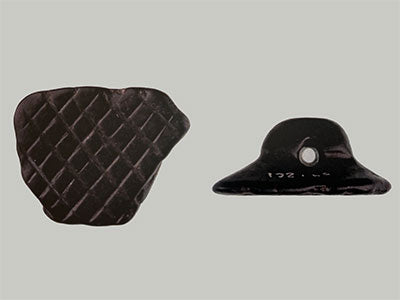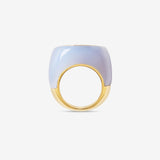HASHTAG RING IN CHALCEDONY
MANUAL EDITION
ANCIENT · MIDDLE EAST
We attend all our customers personally. Please leave us your contact details for information and sales.
We attend all our customers personally. Please leave us your contact details for information and sales.
All our rings are tailor made. Please indicate your size. We will contact you to assure the perfect fitting.
DESCRIPTION
MANUALLY CAST PRINT OF AN ORIGINAL MESOPOTAMIAN GLYPH SEAL (5100 BC) · We use a 7000 year old seal to cast its ageless identity in yellow gold, set in a carved chalcedony stone ring as a testament to the neolithic.
This signet ring is designed as a symbol of identity, everything about it is unique. Each blue chalcedony frame is carved by hand, each gold print is individually cast into a different signature.
-
Available in ring sizes
-
Signet print manually cast in 18k yellow gold
-
Hand carved chalcedony frame
-
Every piece is unique in print and stone

MESOPOTAMIAN GLYPH SEAL (5100 BC)
It is difficult to find an artifact of greater historical significance than the Mesopotamian glyph seal. Image bearing stamps and pendants appeared in the Near Eastern Neolithic around the 6th millennium BC.
In a context of social stratification they were initially used as markers of property, and eventually evolved to symbols of identity, empowering individuals to express their position within an existing social grid.
In parallel, their early use as tokens that were impressed on clay envelopes, gradually became the basis of numerical tablets and ultimately proto-cuneiform, or pictographic and ideographic writing.
It is fair to say that these small, inconspicuous objects played a key role in the birth of social structures like ownership or status, and also in the invention of writing.
Because of their vital importance in the understanding of the birth of modern societies, Mesopotamian glyph seals have been extensively studied by scholars and museums. Hereunder you find some similar references in shape, material and glyph design.



-
S. Denham, Late neolithic and early chalcolithic glyphs and stamp seals in the British museum
-
B. Buchanan, Early near eastern seals in the Yale Babylonian collection
-
C. Atakuman, Deciphering later neolithic stamp seal imagery of northern Mesopotamia
-
L. Gorelick and A. J. Gwinnett, The ancient near eastern cylinder seal as social emblem and status symbol
-
A. Tsuneki, A glimpse of human life from the neolithic cemetery at Tell el-Kerkh, northwest Syria
-
B. Teissier, Ancient near eastern cylinder seals from the Marcopoli collection
Acquired at an antiquities dealer in Washington DC, legally imported to the European Union classified as a collector’s piece of archeological interest. Authenticity has been certified by S.M.G., a member of the Archaeological Institute of America.
Before that the piece was part of the Alex G. Malloy collection, an antiquities gallery in New York during the 70’s and the 80’s.
HASHTAG
Last year, humans created more data than all of history before that. Instagram posts and bank transactions travel around the world at light speed. Infinite knowledge is just one click away. Life is digital. Digital is data. And it all began 9000 years ago with a Mesopotamian farmer stamping a stone seal into wet clay.
Ancient Mesopotamia is widely considered as the cradle of western civilization. Over a span of thousands of years, local farming communities evolved to give birth to urban societies. Trading routes for copper and obsidian covered hundreds of miles. Some 50.000 people lived in Uruk, the world’s first city. This growth in economic and social complexity was fueled by inventions like the wheel, law, mathematics and most importantly script, ca. 3200 BC.

As early trading developed, farmers and traders began to use small seals to mark food or other commodities that were kept in straw baskets or stone containers. Seal stamps were used as records of identity, ownership and material transactions. As administration became more and more complex, this became the basis of numerical tablets, and eventually gave birth to cuneiform script, the world’s first writing. Interestingly, with the birth of the Internet, stamping has made a digital comeback with us tagging posts and pics.
Development also affected social structures. The identity of glyph seals gradually started to take on a meaning of social coherence, and subscription to groups and beliefs. This evolved to the elaborate prints of Assyrian and Babylonian cylinder seals, real objects of art as the ultimate expression of individual identity and of social status. Surprisingly, modern hashtags have recovered this social statement of “I also subscribe to this idea or trend”.
Where digital writing gave birth to hashtags, Mesopotamian stamps gave birth to writing. These small, inconspicuous objects have played a pivotal role in the birth of modern societies. Glyph seals were designed to be used, and worn to be seen as tokens of status and belief.
History is identity.









